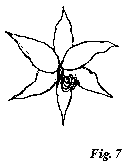V. BYZANTINE PALACES 155
inner petal, on which the stamens rest, contracts itself into the narrowest of the six, and the three under petals remain of one intermediate magnitude, as seen in the annexed figure.
§ 13. I must not, however, weary the reader with this subject, which has always 
§ 14. In every one of the buildings above mentioned, except the Rio-Foscari House (which has only one great entrance between its wings), the central arcades are sustained, at least in one story, and generally in both, on bold detached cylindrical shafts, with rich capitals, while the arches of the wings are carried on smaller shafts assisted by portions of wall, which become pilasters of greater or less width.
And now I must remind the reader of what was pointed out above (Vol. I. Chap. XXVII. §§ 3, 35, 40),2 that there are two great orders of capitals in the world; that one of these is convex in its contour, the other concave; and that richness of ornament, with all freedom of fancy, is for the
1 [See, for instance, the discussion of the principles of proportion founded on a stem of the water plaintain (Alisma plantago) in Seven Lamps, Vol. VIII. pp. 168, 169.]
2 [Of The Stones of Venice, Vol. IX. pp. 360, 379, 383, in this edition.]
[Version 0.04: March 2008]